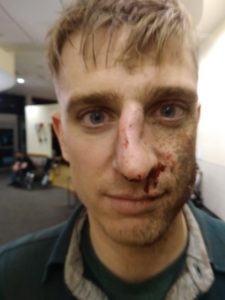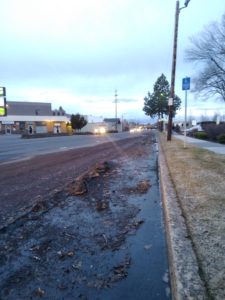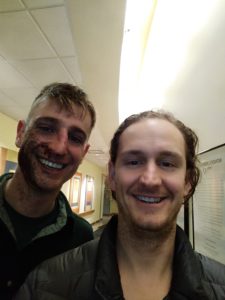A little more than a month ago, I was commuting home from a screening of a ski movie at a local shop at around 8:45 PM. I was traveling down the protected bike lane on Wall Street Northbound between Greenwood/Newport and Olney/Portland, when I hit a pile of snow that I didn’t see and flipped over my handlebars and onto the pavement. After looking at my helmet and injuries it appears as if I landed squarely on the front of my face and my helmet’s brim shifted the impact to a single side, likely sparing me from far worse damage. After receiving no help or apparent regard from passersby, I checked my reflection in a parked car’s window and called a great friend for a ride to the emergency room. Following hours in the emergency room, I was discharged with a broken nose, road rash, and a forthcoming fear of my primary means of transportation. I want to share my experience, so I made a list of observations:
- I feel shame about crashing my bike and I feel lucky to be in as good of shape as I am
- Ultimately I wasn’t riding at a speed and level of awareness that allowed me to get home safely, so primarily I accept responsibility for not taking care of myself
- The road condition that contributed to my crash wouldn’t be tolerated in the general travel lanes so long after a storm, but it is in the bike lane because bicycling (along with walking and riding transit) is treated as a second-class mode of transportation
- Bend’s Public Works Department is led and staffed by hard-working and capable people who have made this year’s abnormal snowfall feel more or less normal. They have been absolutely slammed this winter and have continued to exceed what should be expected of them, while incessant complaints about Bend’s snow removal policy and execution are directed at them. The community is constantly asking them to maintain and clear more infrastructure, some of which requires different equipment and expertise, without the additional funding to do so
- The semi-frequent honks, close passes, and gestures from motorists make me feel unsafe and like a nuisance. I have been feeling more salty about this with debris filled bike lanes that make riding separately from car traffic more difficult
- When riding in adverse conditions, and also generally, way more motorists express support than animosity


Three or four days after my crash, I got back on my bike to go to a coffee shop and an evening class I have been taking through COCC. I spent most of my time riding feeling nervous and acutely aware of dangers that I had never even thought about before. At the corner of Oregon and Lava downtown, a UPS delivery didn’t see me in broad daylight and continued through a stop sign, requiring me to skid to a stop. In the past this would have been frustrating but no big deal. On that day, it felt terrifying and really threw me off. I pulled over and took five or ten minutes to calm down before I continued on to class.
For the following week I rented a car and reconsidered whether I really wanted to complete my first year in Bend without owning a car. After taking some time to calm down and think about the risks of bike commuting and all of the great things it adds to my life, I decided to stay the course and to try to make it until July. Also a local ENT doctor hit the reset button on my nose so it’s more or less back to normal now 🙂
To conclude positively, I will leave you with some thoughts about the role of alternative transportation options in Bend’s future.
Bend is growing really rapidly. The Population Research Center at Portland State University estimates that Bend’s population will go from 85,737 in 2015 to 132,209 in 2035, and then to 194,793 in 2065. Where do you expect all of those people to live, work, shop, and play? And how do you expect them to travel between all of those places?
Whatever ideas you have need to scale to Bend’s future population, or it will become increasingly sprawling, congested, and inaccessible to everyone. If your idea is more roads and more cars (which it probably isn’t because you’re reading this blog,) then that likely means more five-lane roads and limited-access highways. If that isn’t the direction you want to see Bend grow then we need more dignified and reasonable alternative transportation options to benefit everyone, not only the people who use them.
Bend is still relatively small and early in its development. The status quo is not a curse, but an opportunity if we choose to conceptualize it that way. Right now, alternative modes of transportation are not easy or convenient choices for most Bendites, but the baseline is shifting toward more and better transportation options. Remember that the squeaky wheel gets the grease and keep pushing against the status quo by engaging city councilors, showing up at public meetings, and starting a dialogue the people in your circles.

Editor’s Note: Jackson Lester is a board member of Bend Bikes.
